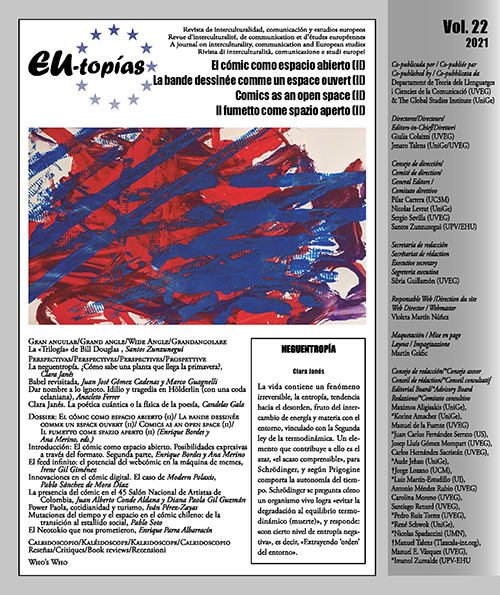Power Paola, every day life and tourism
DOI:
https://doi.org/10.7203/eutopias.22.22932Keywords:
Paola Gaviria, comic, national identity, tourism. Abstract
Abstract
In her graphic novels, Colombian painter and comic book artist Paola Gaviria (aka Power Paola) centralizes the representation of the local» places she visits during her travels. With the cities and the jungles, highways and pathways, bodegas and swamps in her crosshairs, Gaviria’s art dismantles the frontiers that separate both the touristy and mundane spaces her characters occupy. What is exposed in her work, is a version of national space in which public interactions (tinged with the preoccupations about private matters) strip away the stereotypes that plagued the Latin American comic strips of the first half of the twentieth century. This essay describes the processes mentioned above (centralizing and dismantling) to demonstrate how graphic novels invested in the representation of everyday life might appear as lacking an interest in the political realities of the world they capture, even though they propose alternative modes of understanding the neoliberal condition from the perspective of the national identities constituting the space-time fabric of Latina American.
 Downloads
Downloads
 References
References
Alemán, Gabriela. Un antivirus tropical: Powerpaola por fin llega a Ecuador», www.labarraespaciadora.com/entrevistas/un-antivirus-tropical-powerpaola-llega-por-fin-a-ecuador/. Accesado 14 de febrero, 2021.
El tío Berni. Entrevista con PowerPaola.» Entrecomics, www.entrecomics.com/2013/04/entrevista-con-powerpaola/. Accesado 14 de febrero, 2021.
Foster, David William. The Bar as Theatrical Heterotopia: José Muñoz and Carlos Sampayo’s El Bar de Joe.» El Eternauta, Daytripper and Beyond, U of Texas P, 2016, pp. 20-32.
Foucault, Michel. Of Other Spaces: Utopias and Heterotopias.» Trad. Jay Miskowiec, Diacritics
Vol. 16.1, 1967.
Gaviria, Paola. ¡Nos vamos! La Silueta Ediciones, 2016.
— QP: Éramos nosotros. Editorial Común, 2015.
— Todo va a estar bien. La Silueta Ediciones, 2015.
— Virus tropical. Editorial Común, 2014.
González Aranda, Beatriz. Caricatura ‘a sangre y fuego’». La Caricatura en Colombia a Partir de la Independencia, www.banrepcultural.org/la-caricatura-en-colombia/texto17.html. Accesado 14 de febrero, 2021.
Guerra, Pablo. Historieta colombiana de prensa - Adolfo Samper y sus personajes». El Globoscopio, www.elgloboscopio.com/2017/04/historieta-colombiana-de-prensa-adolfo.html. Accesado 14 de febrero, 2021.
Hernández, Richard. Cómics: ¿Cómo surgieron en Colombia?». Radio Nacional de Colombia, www.radionacional.co/noticias/historia-comic-colombia. Accesado 14 de febrero, 2021.
Kincaid, Jamaica. A Small Place. Farrar, Straus and Giroux, 1988.
Lefèvre, Pascal. The Constructions of Space in Comics.» A Comics Studies Reader. Ed. por Jeet Heer y Kent Worcester, UP de Mississippi, 2009, pp. 157-62.
McCloud, Scott. Understanding Comics: The Invisible Art. Harper Collins, 1994.
Downloads
Published
How to Cite
-
Abstract291
-
PDF (Español)222
Issue
Section
License
![]()
The authors conserve the copyright. All content published in EU-topías. Journal of interculturality, Communication, and European Studies are subject to the license Creative Commons Attribution-NonCommercial-ShareAlike 4.0 license. The full text of the license can be found at <http://creativecommons.org/licenses/by-nc-sa/4.0>
They may be copied, used, disseminated, transmitted and publicly displayed, provided that:
- The authorship and original source of the publication is cited (journal, publisher and URL of the work).
- They are not used for commercial purposes.
- The existence and specifications of this license of use are mentioned.
It is the responsibility of the authors to obtain the necessary permissions for images that are subject to copyright.



